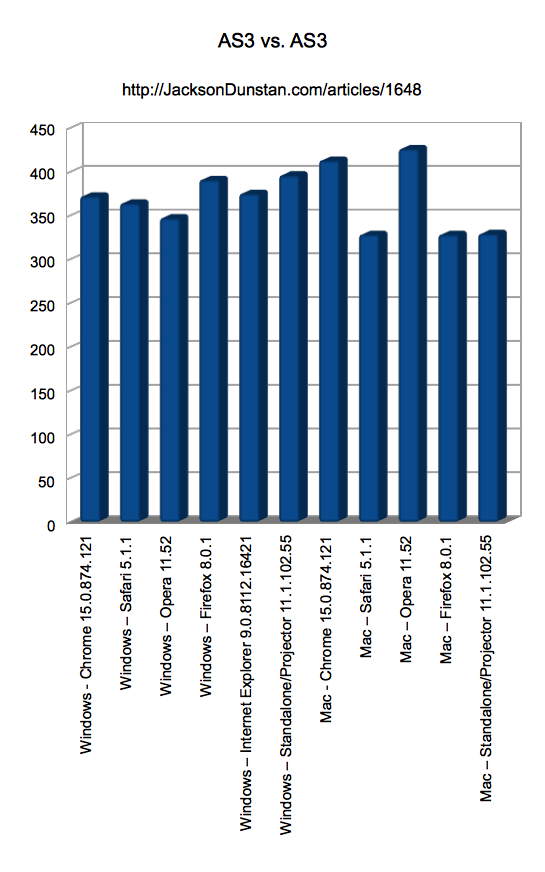AS3 vs. AS3
One frequent request I get on my AS3 vs. JavaScript series is to test AS3 in more environments. Today I’m doing just that and testing its performance in browsers (plugin and ActiveX control) and standalone/projector mode across Mac OS and Windows operating systems. Does it make any difference? Read on to find out!
For this test, I used the same test suite from oddhammer.com that I use in the AS3 vs. JavaScript series. It is not a comprehensive test of all features under all conditions. As such, I recommend viewing the results only as a broad perspective on overall performance. For specific performance characteristics, check out the other AS3 articles on this site.
All tests were conducted with the following environment:
- Flex SDK (MXMLC) 4.5.1.21328, compiling in release mode (no debugging or verbose stack traces)
- Release version of Flash Player 11.1.102.55
- 2.4 Ghz Intel Core i5
- Mac OS X 10.7.2 or Windows 7 Service Pack 1
Here are the total times for all tests on all platforms:
| Platform | Total Time |
|---|---|
| Windows – Chrome 15.0.874.121 | 372 |
| Windows – Safari 5.1.1 | 364 |
| Windows – Opera 11.52 | 347 |
| Windows – Firefox 8.0.1 | 391 |
| Windows – Internet Explorer 9.0.8112.16421 | 375 |
| Windows – Standalone/Projector 11.1.102.55 | 396 |
| Mac – Chrome 15.0.874.121 | 413 |
| Mac – Safari 5.1.1 | 328 |
| Mac – Opera 11.52 | 426 |
| Mac – Firefox 8.0.1 | 328 |
| Mac – Standalone/Projector 11.1.102.55 | 329 |

These results are pretty close to each other. The worst-performing platform is only 30% slower than the best-performing platform. Still, there are some important findings in the above data:
- 64-bit platforms (Safari, Firefox, Standalone/Projector) are much faster on Mac OS X than 32-bit platforms (Chrome, Opera)
- There are no differences on Windows due to 64-bit and 32-bit
- Standalone/projector builds don’t execute AS3 any faster than other platforms
- AS3 is a little quicker on Mac OS X than Windows
- Internet Explorer—the only ActiveX platform—isn’t especially faster or slower than the other AS3 platforms
Overall, I’d say that AS3 performance is pretty much the same on all of these platforms. The only clear-cut winner is the 64-bit plugin support on Mac OS X, which seems to deliver a 30% speed boost. But, since most users will not be running on this platform, it’d be foolish to assume they will get this speedup. So, when performing speed tests on a “minimum system specification” machine, make sure you do it in a 32-bit environment on Mac OS X.
Raw data spreadsheets: Open Document Format (ODS) , Excel (XLS).
Spot a bug? Have a suggestion? Post a comment!
#1 by grapefrukt on November 28th, 2011 ·
The developer channel of Chrome now has the “pepper” version of flash player that uses their new fancy ppapi to run Flash in separate render processes instead of a central plugin process. I wonder what that would do for performance?
#2 by Ross R on November 28th, 2011 ·
I would be very interested in seeing these numbers stacked up side-by-side with mobile platform flashPlayer performance.
#3 by jackson on November 28th, 2011 ·
I’d like to do that test too, but it would be hard to compare apples to apples there since the mobile version would necessarily be run on different hardware than my MacBook Pro. Even a “mobile vs. mobile” would be difficult since, for example, the iPhone 4S runs on different hardware than a Galaxy Nexus. I’d either need to do some serious hacking and dual boot (probably still unfair) or try to compare similar hardware (which would still be a little skewed).
Any other ideas would be much appreciated. :)
#4 by Elliot J Geno on November 28th, 2011 ·
Yeah! Bring on the mobile! I have found that my flash work has been running very well on mobile. This is why I was surprised they stopped developing for it.
#5 by jackson on November 28th, 2011 ·
Just to clarify, they only stopped developing the mobile browser plugin. Mobile AIR (i.e. for mobile apps) is alive and well.
#6 by Kyle Murray / Krilnon on November 29th, 2011 ·
The use of ahead-of-time compilation for iOS AIR (and maybe other mobile platforms?) seems like it would change performance properties somewhat.
#7 by philmill on December 15th, 2011 ·
From my experience, IE seems to perform better under multimedia loads. I know your test doesn’t include multimedia, but I just thought I would leave a comment. This is based primarily on TweenLite photo montages and other simple slide/fade animations. I’ve seen at most a 30% difference between FF and IE (I can’t remember Webkit based results).
As a suggestion, possibly use TweenLite to test simple slide/fade animations of sprites, raster-ed images, and other display objects. This would be great to see in your VS Javascript using jQuery or other framework animations.
Thanks for all your effort,
Phil